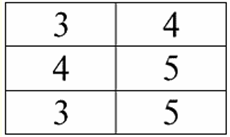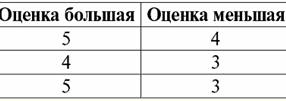Table of contents (expand)
- Relational Data Objects (Requirements for the tabular form of representing relationships. Domains and attributes. Relationship schemas. Named values of tuples. Tuples. Types of tuples. Relations. Types of relations)
- Relational algebra. Unary operations (Unary selection operation. Unary projection operation. Unary renaming operation. Properties of unary operations)
- Relational algebra. Binary operations (Operations of union, intersection, difference. Operations of Cartesian product and natural join. Properties of binary operations. Variants of join operations. Derived operations. Relational algebra expressions)
- SQL language (The Select operator is the basic operator of the structured query language. Unary operations in the structured query language. Binary operations in the structured query language. Cartesian product operation. Inner join operations. Natural join operation. Left outer join operation. Right outer join operation. Full outer join operation )
- Basic Relationships (Basic data types. Custom data type. Default values. Virtual attributes. Concept of keys)
- Creating Basic Relationships (Metalinguistic symbols. An example of creating a base relation in a pseudocode record. Stateful integrity constraints. Referential integrity constraints. The concept of indexes. Modification of base relations)
- Functional dependencies (Functional dependence restriction. Armstrong's inference rules. Derived inference rules. Completeness of the Armstrong rule system)
- Normal forms (The meaning of normalizing database schemas. First normal form (1NF). Second normal form (2NF). Third normal form (3NF). Boyce-Codd normal form (NFBC). Nesting of normal forms)
- Database Schema Design (Different types and multiplicities of connections. Diagrams. Types of diagrams. Relationships and key migration)
- Entity class relationships (Hierarchical recursive communication. Network recursive communication. Association. Generalizations. Composition. Aggregation. Attribute unification)
- Expert systems and production model of knowledge (Purpose of expert systems. Structure of expert systems. Participants in the development of expert systems. Modes of operation of expert systems. Product model of knowledge)
Lecture No. 1. Introduction
1. Database management systems
Database management systems (DBMS) are specialized software products that allow:
1) permanently store arbitrarily large (but not infinite) amounts of data;
2) extract and modify these stored data in one way or another, using so-called queries;
3) create new databases, i.e. describe logical data structures and set their structure, i.e. provide a programming interface;
4) access stored data by several users at the same time (i.e. provide access to the transaction management mechanism).
Accordingly, the Database are datasets under the control of management systems.
Now database management systems are the most complex software products on the market and form its basis. In the future, it is planned to conduct developments on a combination of conventional database management systems with object-oriented programming (OOP) and Internet technologies.
Initially, DBMS were based on hierarchical и network data models, i.e. allowed to work only with tree and graph structures. In the process of development in 1970, there were database management systems proposed by Codd (Codd), based on relational data model.
2. Relational databases
The term "relational" comes from the English word "relation" - "relationship".
In the most general mathematical sense (as can be remembered from the classical set algebra course) respect - it's a set
R = {(x1,..., xn) | x1 ∈ A1, ..., xn ∈ An},
where A1,...,An are the sets forming the Cartesian product. In this way, ratio R is a subset of the Cartesian product of sets: A1 x... x An :
R ⊆ A 1 x... x An.
For example, consider the binary relations of the strict order "greater than" and "less than" on the set of ordered pairs of numbers A 1 = A2 = {3, 4, 5}:
R> = {(3, 4), (4, 5), (3, 5)} ⊂ A1 xA2;
R< = {(5, 4), (4, 3), (5, 3)} ⊂ A1 xA2.
These relationships can be presented in the form of tables.
Ratio "greater than">:

Ratio "less than" R<:

Thus, we see that in relational databases, a wide variety of data is organized in the form of relationships and can be presented in the form of tables.
It should be noted that these two relations R> and R< are not equivalent to each other, in other words, the tables corresponding to these relationships are not equal to each other.
So, the forms of data representation in relational databases can be different. How does this possibility of different representation manifest itself in our case? Relations R> and R< - these are sets, and a set is an unordered structure, which means that in tables corresponding to these relationships, rows can be interchanged. But at the same time, the elements of these sets are ordered sets, in our case - ordered pairs of numbers 3, 4, 5, which means that the columns cannot be interchanged. Thus, we have shown that the representation of a relation (in the mathematical sense) as a table with an arbitrary order of rows and a fixed number of columns is an acceptable, correct form of representation of relations.
But if we consider the relations R> and R< from the point of view of the information embedded in them, it is clear that they are equivalent. Therefore, in relational databases, the concept of "relationship" has a slightly different meaning than a relation in general mathematics. Namely, it is not related to the ordering by columns in a tabular form of presentation. Instead, so-called "row - column heading" relationship schemes are introduced, i.e., each column is given a heading, after which they can be freely swapped.
This is what our R relationships will look like> and R< in a relational database.
A strict order relation (instead of the relation R>):

A strict order relation (instead of the relation R<):

Both tables-relationships get a new one (in this case, the same, since by introducing additional headers we have erased the differences between the relations R> and R<) title.
So, we see that with the help of such a simple trick as adding the necessary headers to the tables, we come to the fact that the relations R> and R< become equivalent to each other.
Thus, we conclude that the concept of "relationship" in the general mathematical and relational sense does not completely coincide, they are not identical.
Currently, relational database management systems form the basis of the information technology market. Further research is being carried out in the direction of combining varying degrees of the relational model.
>> Forward: Missing data (Empty values. Null values. Null values and the general rule for evaluating expressions. Null values and logical operations. Null values and testing conditions)
 We recommend interesting articles Section Lecture notes, cheat sheets:
We recommend interesting articles Section Lecture notes, cheat sheets:
▪ Medical physics. Crib
▪ Stocks and bods market. Crib
▪ Foreign literature of ancient eras, the Middle Ages and the Renaissance in brief. Crib
 See other articles Section Lecture notes, cheat sheets.
See other articles Section Lecture notes, cheat sheets.
 Read and write useful comments on this article.
Read and write useful comments on this article.
<< Back
 Latest news of science and technology, new electronics:
Latest news of science and technology, new electronics:
The existence of an entropy rule for quantum entanglement has been proven
09.05.2024
Quantum mechanics continues to amaze us with its mysterious phenomena and unexpected discoveries. Recently, Bartosz Regula from the RIKEN Center for Quantum Computing and Ludovico Lamy from the University of Amsterdam presented a new discovery that concerns quantum entanglement and its relation to entropy. Quantum entanglement plays an important role in modern quantum information science and technology. However, the complexity of its structure makes understanding and managing it challenging. Regulus and Lamy's discovery shows that quantum entanglement follows an entropy rule similar to that for classical systems. This discovery opens new perspectives in the field of quantum information science and technology, deepening our understanding of quantum entanglement and its connection to thermodynamics. The results of the study indicate the possibility of reversibility of entanglement transformations, which could greatly simplify their use in various quantum technologies. Opening a new rule ... >>
Mini air conditioner Sony Reon Pocket 5
09.05.2024
Summer is a time for relaxation and travel, but often the heat can turn this time into an unbearable torment. Meet a new product from Sony - the Reon Pocket 5 mini-air conditioner, which promises to make summer more comfortable for its users. Sony has introduced a unique device - the Reon Pocket 5 mini-conditioner, which provides body cooling on hot days. With it, users can enjoy coolness anytime, anywhere by simply wearing it around their neck. This mini air conditioner is equipped with automatic adjustment of operating modes, as well as temperature and humidity sensors. Thanks to innovative technologies, Reon Pocket 5 adjusts its operation depending on the user's activity and environmental conditions. Users can easily adjust the temperature using a dedicated mobile app connected via Bluetooth. Additionally, specially designed T-shirts and shorts are available for convenience, to which a mini air conditioner can be attached. The device can oh ... >>
Energy from space for Starship
08.05.2024
Producing solar energy in space is becoming more feasible with the advent of new technologies and the development of space programs. The head of the startup Virtus Solis shared his vision of using SpaceX's Starship to create orbital power plants capable of powering the Earth. Startup Virtus Solis has unveiled an ambitious project to create orbital power plants using SpaceX's Starship. This idea could significantly change the field of solar energy production, making it more accessible and cheaper. The core of the startup's plan is to reduce the cost of launching satellites into space using Starship. This technological breakthrough is expected to make solar energy production in space more competitive with traditional energy sources. Virtual Solis plans to build large photovoltaic panels in orbit, using Starship to deliver the necessary equipment. However, one of the key challenges ... >>
 Random news from the Archive Random news from the Archive The strongest robot
10.01.2008
Robot "Titan", created by the German company "KUKA", fully corresponds to its name.
Its iron arm, which has six degrees of freedom, manipulates loads weighing more than a ton, that is, "Titan" is capable, for example, of lifting and turning an almost finished car, substituting its different points for another robot - a welder. Movement "hands" provide nine electric motors. The strongest robot in the world has already entered the Guinness Book of Records.
|
 Other interesting news:
Other interesting news:
▪ Tram without wires
▪ Motorola MOTOTRBO SL1600 digital portable radio
▪ Microchip controls muscles
▪ Sweet lovers are prone to alcoholism
▪ Dream control device
 News feed of science and technology, new electronics
News feed of science and technology, new electronics
 Interesting materials of the Free Technical Library:
Interesting materials of the Free Technical Library:
▪ site section Tone and volume controls. Article selection
▪ article Cross the Rubicon. Popular expression
▪ article What is curling? Detailed answer
▪ article The damaging effect of electric current on the human body
▪ article Wow prefix. Encyclopedia of radio electronics and electrical engineering
▪ article Pulse-width controllers of the KR1156EU2 and KR1156EUZ series. Encyclopedia of radio electronics and electrical engineering
 Leave your comment on this article:
Leave your comment on this article:
 All languages of this page
All languages of this page
Home page | Library | Articles | Website map | Site Reviews

www.diagram.com.ua
2000-2024







 Arabic
Arabic Bengali
Bengali Chinese
Chinese English
English French
French German
German Hebrew
Hebrew Hindi
Hindi Italian
Italian Japanese
Japanese Korean
Korean Malay
Malay Polish
Polish Portuguese
Portuguese Spanish
Spanish Turkish
Turkish Ukrainian
Ukrainian Vietnamese
Vietnamese





 See other articles Section
See other articles Section 